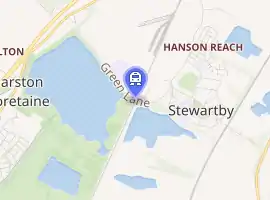Stewartby railway station
Stewartby railway station is a station on the London Northwestern Railway, which serves the Bedfordshire village of Stewartby in England. It is the nearest station to the Marston Vale Millennium Country Park.
 Looking north-east with three of the four surviving and listed brickworks chimneys in view | |
| Location | Stewartby, Bedford England |
| Coordinates | 52.069°N 0.521°W |
| Grid reference | TL014422 |
| Managed by | London Northwestern Railway |
| Platforms | 2 |
| Other information | |
| Station code | SWR |
| Classification | DfT category F2 |
| Key dates | |
| 1905 | Opened as Wootton Pillinge Halt |
| 1 January 1917 | Temporarily closed |
| 5 May 1919 | Reopened |
| 1 January 1928 | Renamed Wootton Pillinge |
| 8 July 1935 | Renamed Stewartby[1] |
| 15 July 1968 | Became unstaffed[2] |
| Passengers | |
| 2015/16 | |
| 2016/17 | |
| 2017/18 | |
| 2018/19 | |
| 2019/20 | |
| Location | |

| |
| Notes | |
Passenger statistics from the Office of Rail and Road | |
Services
Stewartby station, in common with others on the Marston Vale Line, is covered by the Marston Vale Community Rail Partnership,[3] which aims to increase use of the line by involving local people. An hourly service runs in each direction Monday to Saturday, but no trains call on Sundays.[4]
| Preceding station | Following station | |||
|---|---|---|---|---|
| London Northwestern Railway Marston Vale Line Mondays-Saturdays only |
History
When first opened in 1905 by the London and North Western Railway, the station was a halt serving the small village of Wootton Pillinge, a largely rural community that, in 1897, had become the site of B.J.H. Forder's brickworks. The plant was served by sidings close to and alongside the halt which were controlled by a signal box;[5] the halt was simply constructed with a platform at ground level constructed out of sleepers.[6] By 1910, the Wootton Pillinge Brick Company was selling 48 million bricks per year and in 1923, it merged with the London Brick Company (LBC). The brickworks developed virtually across the railway line and as the wagon capacity of the old sidings was exceeded, they became an extension for a larger group of sidings developing at Wootton Broadmead. The Wootton Pillinge signal box was closed and a new box was opened called "Forder's Sidings" which controlled heavy movements from the works.[7]
In 1926 the LBC began to build a "garden village" for its employees at Wootton Pillinge; the village was to be named "Stewartby" after Sir Halley Stewart, the former Liberal Parliamentary candidate for Peterborough and first chairman of the Wootton Pillinge Brick Company. Following the building of the village, the London, Midland and Scottish Railway renamed the station (which ceased to be a halt in 1928) to Stewartby.[8] The Stewartby brickworks was connected to the Marston Vale Line via a 2 ft 11 in (889 mm) narrow gauge railway operating on overhead electrification. This is believed to have been installed in the 1930s and lasted until 1960.[9] After reaching a peak production level of 738 million bricks in 1973, demand for bricks declined and the LBC (trading as Easidispose) signed an agreement the following year to re-use its empty clay pits as landfill transported from London. One or two daily container trains began transporting 1,000 tons of waste from Hendon to handling facilities at Stewartby.[10]
| Preceding station | Disused railways | Following station | ||
|---|---|---|---|---|
| Millbrook | British Railways Varsity Line |
Wootton Broadmead Halt |
References
- Butt, R.V.J. (1995). The Directory of Railway Stations. Sparkford: Patrick Stephens Ltd. p. 255. ISBN 1-85260-508-1.
- Clinker, C.R. (1978). Clinker's Register of Closed Passenger Stations and Goods Depots in England, Scotland and Wales 1830-1977. Bristol: Avon-AngliA Publications & Services. p. 164. ISBN 0-905466-19-5.
- Marston Vale Community Rail Partnership
- Table 64 National Rail timetable, May 2016
- Simpson 1981, p. 65.
- Simpson 2000, p. 77.
- Simpson 2000, p. 74.
- Simpson 1981, p. 69.
- Simpson 1981, p. 62.
- Simpson 1981, p. 66.
Sources
- Simpson, Bill (1981). Oxford to Cambridge Railway. 2. Poole: Oxford Publishing Co. ISBN 0-86093-121-8.CS1 maint: ref=harv (link)
- Simpson, Bill (2000). The Oxford to Cambridge Railway: Forty Years On 1960-2000. Witney: Lamplight Publications. ISBN 1-899246-05-3.CS1 maint: ref=harv (link)
External links
| Wikimedia Commons has media related to Stewartby railway station. |
- Train times and station information for Stewartby railway station from National Rail